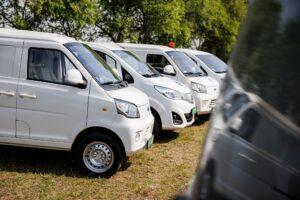The new era of electromobility: why do Hungarian automotive players need to act now?
China is racing towards electric mobility, Europe is gaining momentum again, the US is slowing down – according to EY’s global forecast, hybrid technologies will play a key role in the next decade. Based on the consulting firm’s model, the share of pure electric vehicle sales could exceed 50% in the three largest markets by 2034, while hybrids and plug-in hybrids could gain a market share of over 30% by 2036.
China: full steam ahead
 According to EY’s global model, pure electric cars could account for more than half of light vehicle sales in China by 2033. The combined market share of electric cars, hybrids and plug-in hybrids could reach 50% as early as 2025, and after 2034 this proportion could rise to over 90%. Growth is driven by a stable industrial policy, a mature supplier ecosystem and price competition.
According to EY’s global model, pure electric cars could account for more than half of light vehicle sales in China by 2033. The combined market share of electric cars, hybrids and plug-in hybrids could reach 50% as early as 2025, and after 2034 this proportion could rise to over 90%. Growth is driven by a stable industrial policy, a mature supplier ecosystem and price competition.
“China is setting an example of how capacity, technological capability and affordable prices can be created simultaneously. It is a lesson for both the European and American markets that developing the entire value chain – from cell production to software competencies – provides a strategic competitive advantage,”
– said Tamás Szűcs, EY Tax Partner and Head of Automotive Services.
The country’s results are also supported by global trends: according to the International Energy Agency, more than 17 million electric cars will be sold worldwide in 2024, with the growth largely due to China’s performance.
Europe: temporary slowdown, then recovery
In Europe, between 2025 and 2027, a more restrained incentive system, the macroeconomic environment and easing emission sanctions may temporarily slow the rise of electric cars; however, stricter CO₂ limits and the arrival of more affordable models are expected to bring about a turnaround from 2028. According to EY’s forecast, these vehicles could reach a market share of over 50% by 2032.
“In Europe, the next two years are about recalibration: rationalizing the supply, permanently reducing the cost level and rebuilding customer confidence. The role of hybrids – as an affordable, compromise solution – will increase in value, but the market will clearly return to pure electric due to tightening fleet emission targets”
– emphasized Tamás Szűcs.
United States: slowing trajectory
The EY analysis expects a one-off demand “peak” in the short term due to purchases before the tax breaks given in the USA expire. In the longer term, however, due to the phasing out of incentives, tariffs and shortcomings in charging infrastructure, the proportion of purely electric cars in the states may only reach 50% later than previously forecast – the current forecast indicates 2039.
Bridge to a purely electric future: the lasting role of hybrids
According to EY, the combined weight of hybrids and plug-in hybrids may remain permanently above 30% in the three major markets by 2036; this helps to bridge price sensitivity, the heterogeneity of the charging infrastructure and the fact that consumer habits are slowly changing.
“In the first half of the next decade, the automotive industry is experiencing a transitional period: the hybrid portfolio is not a step back, but risk management. The goal remains the same: making purely electric cars widely available”
– said Tamás Szűcs.
The expert added that those manufacturers and suppliers operating in Hungary who are able to rationalize today will gain market share in the next cycle. An independent consultant in this process can not only be a compass in the maze of regulations, tariffs and various incentives, but also a catalyst in enabling companies to move faster, with less risk and greater local added value.
Related news
Artificial intelligence will also transform taxation
🎧 Hallgasd a cikket: Lejátszás Szünet Folytatás Leállítás Nyelv: Auto…
Read more >Consider these things before buying an electric car
🎧 Hallgasd a cikket: Lejátszás Szünet Folytatás Leállítás Nyelv: Auto…
Read more >EY: There is a climate plan, but little real action
🎧 Hallgasd a cikket: Lejátszás Szünet Folytatás Leállítás Nyelv: Auto…
Read more >Related news
Superbrands celebrated again in 2025
🎧 Hallgasd a cikket: Lejátszás Szünet Folytatás Leállítás Nyelv: Auto…
Read more >László Pekó: “Coop isn’t just a network, it is a way of life – and has been for 30 years”
🎧 Hallgasd a cikket: Lejátszás Szünet Folytatás Leállítás Nyelv: Auto…
Read more >(HU) Karácsonyi tv-reklámok 2025 – indul a közönségdíj szavazás
🎧 Hallgasd a cikket: Lejátszás Szünet Folytatás Leállítás Nyelv: Auto…
Read more >






